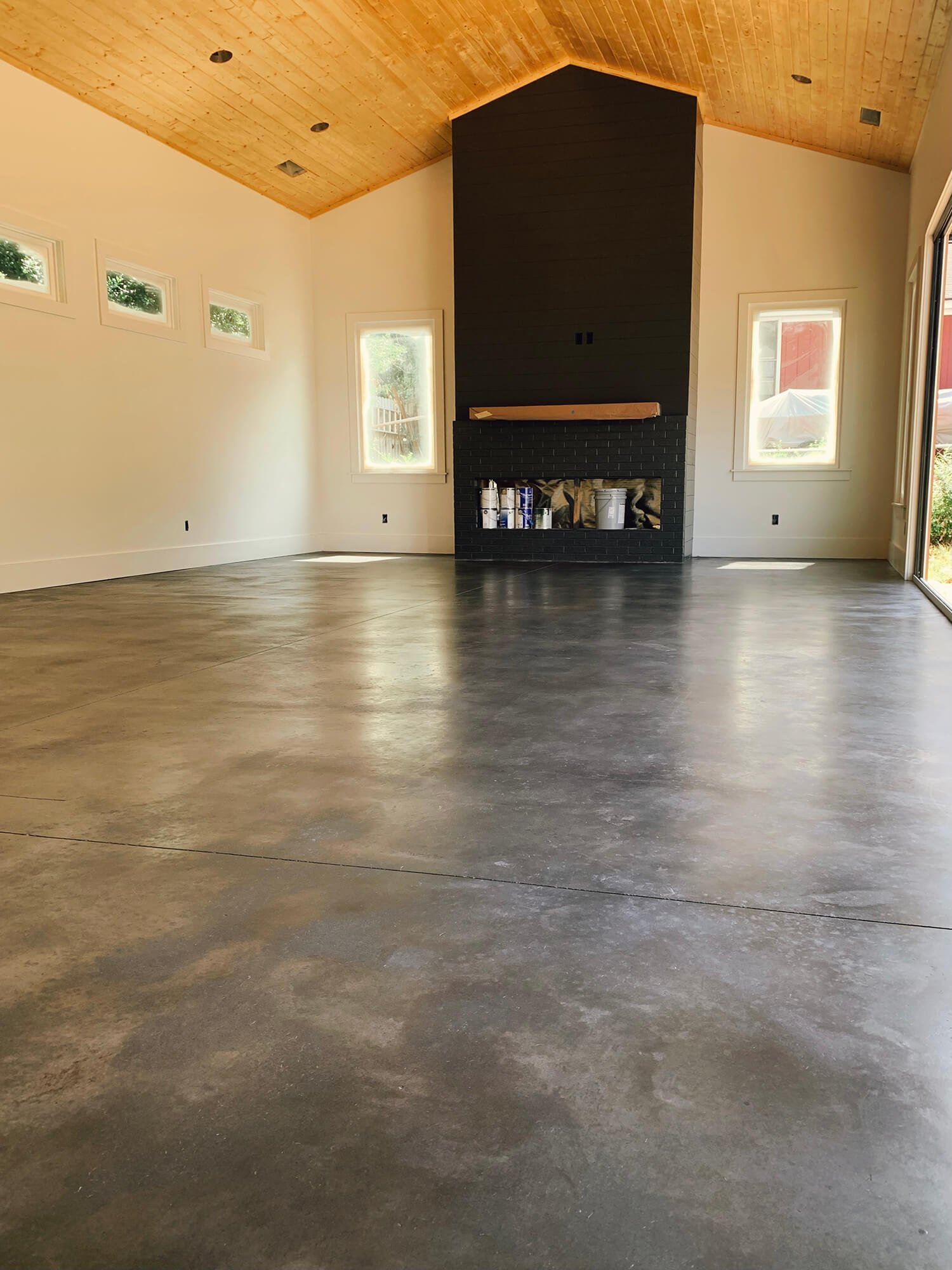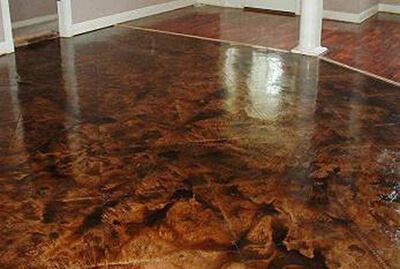Why designers in Austin love stained concrete austin
All Concerning Stained Concrete: A Comprehensive Guide to Its Benefits and Applications
Stained concrete has actually become a preferred option for both domestic and industrial areas. Its capacity to incorporate aesthetic appeal with functionality makes it an appealing choice. Various discoloration techniques use a series of shades and finishes, permitting modification. The advantages extend past appearance. Understanding its applications and maintenance requirements is essential for any individual considering this versatile material. The nuances of stained concrete welcome further exploration.
What Is Stained Concrete?

Staining can be put on various surfaces, consisting of floorings, driveways, and patio areas, making it a flexible option for both indoor and outdoor rooms. The therapy can achieve a variety of looks, from natural tones to bold, contemporary layouts. Unlike paint, stained concrete keeps its look in time, as it ends up being an integral part of the concrete itself. Generally, stained concrete functions as an effective technique for transforming ordinary concrete into visually striking surface areas.
Advantages of Stained Concrete
Stained concrete deals considerable advantages, especially in aesthetic appeal and sturdiness - Stained Concrete Floors Austin Texas. Its dynamic shades and unique patterns boost the visual appeal of any kind of room, making it a popular choice for both residential and commercial applications. In addition, the long life of stained concrete assurances that it continues to be a functional financial investment in time, resisting damage
Aesthetic Appeal
One of one of the most engaging benefits of using stained concrete is its amazing visual charm. Stained concrete offers a distinct and flexible look that can enhance various style styles, from contemporary to rustic. The mixture of lively colors and intricate patterns allows homeowners and developers to produce customized surfaces that can improve the overall atmosphere of a space. Unlike standard flooring alternatives, stained concrete can mimic the appearance of all-natural stone or sleek marble, supplying a high end look without the associated prices. Additionally, the glossy finish options can show light, further lightening up interiors. This flexibility makes stained concrete a popular choice for both household and business applications, where visual influence is critical.
Resilience and Longevity
The impressive visual high qualities of stained concrete are complemented by its exceptional resilience and longevity - Austin Stained Concrete Floors. Stained concrete surfaces are resistant to deterioration, making them appropriate for high-traffic areas both indoors and outdoors. Their robust nature means they can hold up against extreme weather, including severe temperature levels, rain, and UV exposure, without substantial destruction. In addition, stained concrete calls for very little upkeep contrasted to various other floor covering options, as it does not need constant securing or redecorating. This longevity not only minimizes substitute expenses but additionally contributes to a sustainable structure approach. Generally, stained concrete supplies an enduring solution that combines visual allure with practical advantages, guaranteeing its value in time
Various Types of Staining Techniques
Various discoloration techniques can significantly impact the visual top qualities of concrete surface areas. The three main methods include acid discoloration, which reacts chemically with the concrete, water-based staining, which offers a wider variety of colors, and overlay staining choices that give a fresh surface area. Each strategy has unique qualities and applications that satisfy various style preferences and task needs.
Acid Staining Approach
Just how can home owners change plain concrete surfaces into aesthetically striking functions? One efficient approach is acid staining, a popular technique that improves the natural elegance of concrete. This procedure involves using a remedy of water, hydrochloric acid, and metallic salts to the concrete surface. As the acid responds with the lime existing in the concrete, it produces abundant, variegated shades that look like marble or rock. Acid staining is understood for its sturdiness and resistance to fading, making it a long-lasting choice for both indoor and outdoor applications. It is important to note that the results can vary based on the initial concrete shade and texture. Appropriate application and sealing are important for accomplishing the wanted aesthetic and longevity
Water-Based Discoloration Strategy
A prominent choice to acid staining, the water-based staining technique supplies homeowners a functional method to enhance concrete surfaces. This method uses water-soluble dyes and pigments, enabling a wide range of colors and finishes. Unlike acid discolorations, water-based spots can be used to unsealed concrete and offer a less complicated cleanup procedure. The results can accomplish a more uniform appearance and can be layered to produce unique results. Furthermore, water-based spots are normally less hazardous and read the full info here emit less unpredictable natural substances (VOCs), making them a lot more eco friendly. Property owners might appreciate the capacity to tailor their concrete surfaces with various shades, permitting innovative expression while preserving durability and long life in their floor covering selections.
Overlay Staining Options
Numerous overlay staining alternatives exist for home owners looking to rejuvenate their concrete surface areas. One preferred choice is acid discoloration, which reacts chemically with the concrete to produce abundant, variegated colors. Another alternative is water-based staining, supplying a wider color palette and easier application. Additionally, concrete overlays can be incorporated with patterns for elaborate layouts, boosting aesthetics. For a much more textured finish, home owners may take into consideration using stamped overlays that imitate natural materials like rock or tile. Each strategy provides special benefits, from longevity to modification, enabling a personalized touch. Inevitably, the option of overlay staining relies on the preferred appearance and the problem of the existing concrete, making certain a revitalized and appealing surface.
Applications of Stained Concrete
Stained concrete deals a flexible solution for different applications, enhancing both visual appeal and performance. This material is frequently made use of in residential, business, and commercial settings, making it a popular option amongst designers and designers. In homes, stained concrete can act as elegant floor covering or outside patio areas, supplying an advanced appearance while staying durable.
In industrial areas, such as retail shops and restaurants, stained concrete adds to a contemporary atmosphere and can hold up against heavy foot traffic. Furthermore, stained concrete is significantly used in public rooms like parks and walkways, where its ability to mimic all-natural rock or various other products adds visual interest.
Stained concrete is ideal for swimming pool decks and driveways, offering a slip-resistant surface that is easy to preserve. On the whole, the adaptability of stained concrete makes it ideal for many settings, dealing with varied tastes and demands.
Upkeep and Treatment for Stained Concrete
Appropriate maintenance assures the longevity and appeal of stained concrete surfaces. Regular cleansing is essential; utilizing a moderate cleaning agent and water with a soft-bristle brush helps eliminate dirt and grime without harming the finish. It is advisable to avoid rough chemicals that can remove away the stain or sealant.
Sealing stained concrete is vital for defense against wetness, stains, and use. A high-quality sealer should be reapplied every one to 3 years, depending on the traffic and direct exposure the surface sustains. Furthermore, addressing spills immediately will avoid discoloration and staining.

Expense Factors To Consider for Stained Concrete Projects
When preparing a discolored concrete job, spending plan factors to consider play an important role in identifying the total cost. The costs connected with stained concrete can vary significantly based upon numerous variables. The dimension of the location to be stained straight affects product and labor expenses. Bigger rooms will naturally need more resources. Second, the kind of tarnish chosen-- acid-based or water-based-- can affect prices, with acid discolorations often being extra costly. In addition, the intricacy of the layout, consisting of patterns or several colors, can increase labor expenses. Preparation work, such as cleaning and grinding the concrete surface area, includes to the preliminary expenditures also. The option in between DIY installation and working with a professional service provider will certainly further influence the budget. Recognizing these aspects enables home owners to make enlightened economic choices about their stained concrete tasks, ensuring they achieve the wanted visual within their economic ways.
Tips for Choosing the Right Stained Concrete for Your Space
Picking the ideal stained concrete for a details area involves cautious consideration of numerous factors past just budget plan. One need to evaluate the intended use of the area. High-traffic areas may call for even more long lasting surfaces, while attractive applications can prioritize looks.
The color combination is an additional essential aspect; the chosen tones need to integrate with existing style and lighting. It's additionally essential to consider the surface structure, the original source as smooth surfaces can improve class, while distinctive options might ensure security in damp areas.
Regional environment and environmental conditions play a substantial duty in the long life and upkeep of stained concrete, influencing the option of sealers and finishes.
Seeking advice from with experts can provide useful insights customized to certain requirements, assuring the option of the excellent stained concrete that lines up with both functionality and design.
Frequently Asked Questions
Can Stained Concrete Be Applied Over Existing Floor Covering?
Stained concrete can undoubtedly be used over existing floor covering, offered the surface area is steady and effectively prepared. This technique permits an aesthetic upgrade without the requirement for complete elimination of the initial flooring materials.
The Length Of Time Does Stained Concrete Last?
Stained concrete can last for decades when effectively preserved. Variables such as traffic, ecological problems, and application methods substantially influence its long life, with lots of setups remaining vivid and intact for 10 to 30 years.
Is Stained Concrete Slippery When Wet?
Stained concrete can be unsafe when wet, as the coating might produce a smooth surface area. Utilizing non-slip additives or distinctive coatings can minimize this issue, enhancing safety without compromising the aesthetic allure of the concrete.
Can I Stain Concrete Myself, or Should I Employ a Professional?
The choice to tarnish concrete directly or employ a specialist hinges on ability degree and task complexity. While do it yourself staining can conserve cash, professionals ensure excellent results, particularly for elaborate designs or large surfaces.
What Colors Are Available for Stained Concrete?
The range of shades offered for stained concrete consists of natural tones like browns and tans, vivid shades such as reds and blues, and softer shades like pastels. This scheme permits innovative, personalized design choices.